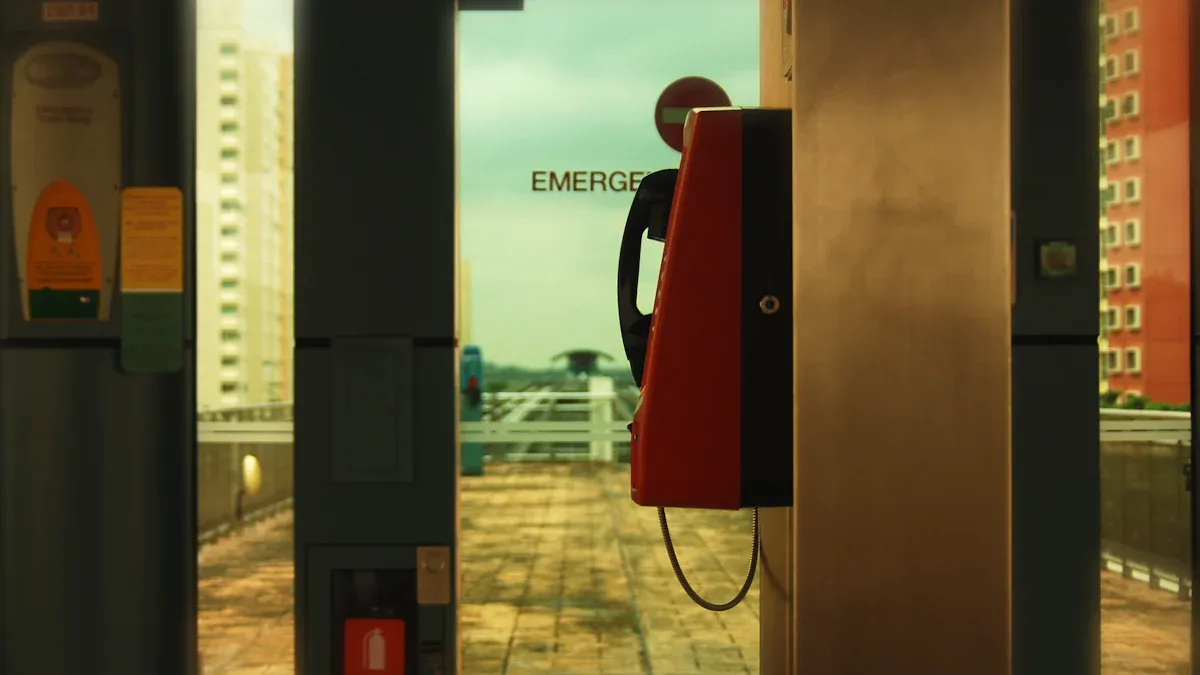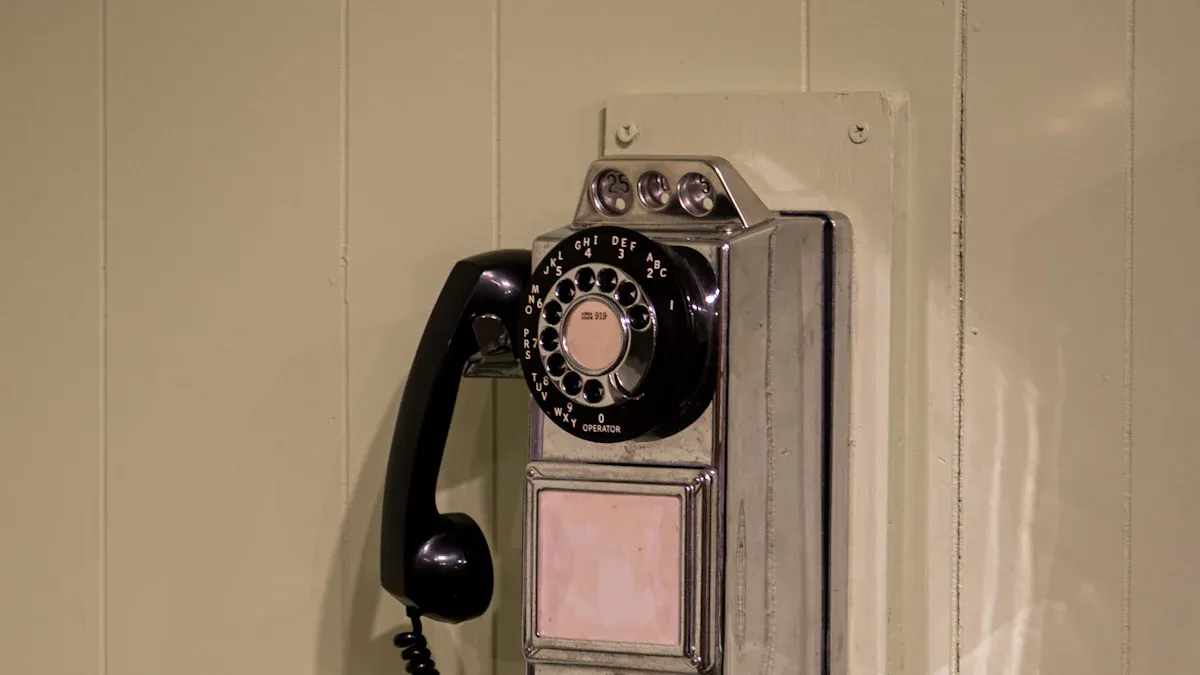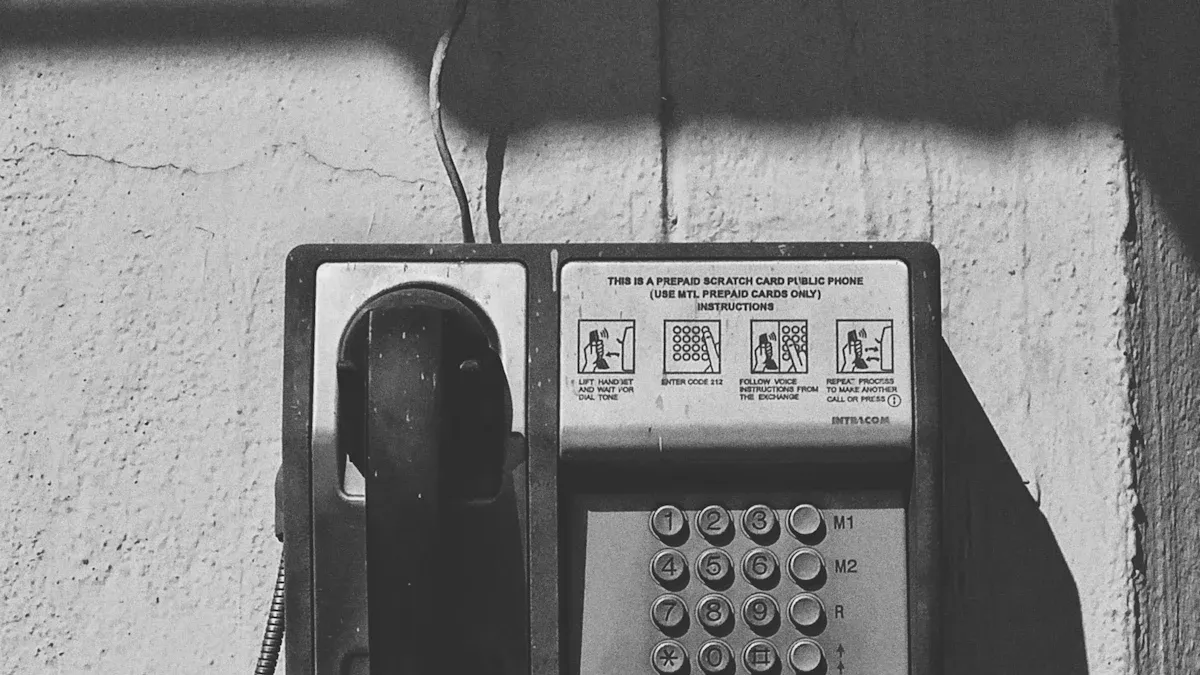
Auto dial emergency telephone systems now deliver faster help during emergencies. Studies in Japan show these phones reduce unnecessary ambulance use by nearly half. Recent advances—like AI call triage, video guidance, and language tools—make every rugged emergency telephone, traffic emergency Telephone, and SOS emergency Telephone more reliable and responsive.
- AI filters non-emergency calls, improving response times.
- Video technology helps dispatchers guide users in real time.
Reliable Auto Dialing in Auto Dial Emergency Telephone
Instant Connection to Emergency Contacts
A reliable auto dial emergency telephone ensures that users reach help quickly when every second counts. Modern systems use advanced technologies like VoIP and automation to deliver messages faster than traditional phone trees. These systems support multichannel communication, including voice, email, SMS, and desktop alerts. They also offer two-way communication, so emergency contacts can confirm receipt of the message in real time. This approach improves the chances of a successful connection during an emergency.
The VIK-E-1600A Emergency Call Box phone stands out as a strong example. It stores emergency numbers and location data in non-volatile memory, so information stays safe even if power is lost. The phone can dial up to five emergency numbers and two central station numbers. If a line is busy or unanswered, the system automatically tries the next number. This process ensures users always have a way to reach someone for help.
Tip: Choose an auto dial emergency telephone with backup dialing features to increase the chance of connecting during critical moments.
Programmable Numbers for Flexibility
Programmable numbers add flexibility and safety to emergency phones. Unlike fixed-number systems, programmable numbers allow users to update or change emergency contacts as needed. Many modern phones use embedded SIMs (eSIMs) that can automatically dial the correct emergency service based on location. This feature works across different regions and countries, making the system more adaptable.
- Remote provisioning lets users update emergency numbers without needing to access the device physically.
- Permanent eSIM integration ensures a reliable connection for emergency calls.
- The system can send GPS location and other important data with the call, helping responders act faster.
- Programmable numbers make the phone compatible with global networks and future changes.
These features help users stay protected, no matter where they are.
Hands-Free Operation in Auto Dial Emergency Telephone
One-Touch or Voice-Activated Calling
One-touch and voice-activated calling features make emergency communication faster and easier. Devices like the Silent Beacon 2.0 allow users to call for help with a single press. This quick action removes the need to search for a phone or remember numbers during stressful moments. For example, a mother who suffered an injury at home pressed her wrist device, which instantly notified her husband, neighbor, and emergency services. Help arrived within minutes. This speed can save lives, especially for children, seniors, or anyone facing a medical crisis.
Statistics show that over one in four seniors experience falls each year. Immediate help can improve their outcomes. Many people also feel unsafe walking alone at night. Devices with instant call features provide peace of mind and ensure rapid response. The ability to alert multiple contacts at once reduces delays and increases safety.
Note: Quick access to emergency help is vital. One-touch and voice-activated features in an auto dial emergency telephone can make a real difference when every second matters.
Accessibility for Users with Disabilities
Auto dial emergency telephones must support users with disabilities. The Americans with Disabilities Act (ADA) sets clear standards for accessibility. Emergency phones should offer direct and equal access for people using TTY (teletypewriter) devices. Operators must keep TTY equipment in good working order and test it as often as regular phones. Staff should receive training to handle TTY calls, including silent calls, and know how to switch between voice and TTY modes.
- Communication methods like Voice Carryover (VCO) and Hearing Carryover (HCO) help users with different needs.
- Regular testing and training ensure that all users get the help they need quickly.
- Both primary and secondary emergency centers must follow these rules.
These steps make sure everyone can use an auto dial emergency telephone in a crisis.
Loud Audio and Visual Alerts in Auto Dial Emergency Telephone
Performance in Noisy or Low-Visibility Environments
Loud audio and visual alerts play a vital role in the effectiveness of any auto dial emergency telephone. In busy environments, such as factories or public spaces, background noise can drown out standard alarms. Multi-tone sirens and bright strobe lights help ensure that emergency notifications reach everyone, even those with hearing impairments or people using noise-canceling headphones. These alerts meet safety codes like NFPA 72 and ADA guidelines, which require both audible and visual signals for maximum coverage.
Recent advances in emergency communication systems use AI and IoT to improve the clarity and timing of alerts. High-quality audio with clear speech and multi-color visual signals make messages easier to understand. These systems can target specific groups and connect with access control or video surveillance, which helps responders act quickly. Cloud-based monitoring adds another layer of reliability, making sure alerts work even if local systems fail.
Operators should not rely only on loudness. Studies show that louder alarms do not always improve response, especially when people face high mental demands. Alarm design should focus on clarity and context, not just volume.
Industry standards set clear rules for emergency alert systems:
- Audible alarms must stand out above background noise.
- Alarms should be unique and easy to recognize.
- Approved devices include air horns, strobe lights, and tactile alerts.
- Systems need regular testing every two months.
- Manual activation devices must be easy to find and use.
- Spare parts and backup power must be available.
- Trained staff should handle maintenance and testing.
A well-designed auto dial emergency telephone uses both sound and light to ensure everyone receives the warning, no matter the environment.
Power Backup and Battery Life in Auto Dial Emergency Telephone
Operation During Power Outages
Power outages can happen at any time. During these moments, an auto dial emergency telephone must keep working. Many leading models use battery backup systems to ensure continuous operation. For example, the Assistive Technology Services Help Dialer uses an AC-powered system with a battery that lasts about two years in standby mode. The battery only activates when the panic button is pressed, which helps extend its life.
Some devices, like the CyberPower PhoneSaver CPS180PHV, provide more than four hours of emergency backup power. This model also includes surge protection and a built-in transformer plug. These features protect the phone and keep it running during outages. The USP Auto Voice Dialer Power Backup Pack offers up to twelve hours of backup power. It activates immediately when the main power fails, so users do not lose connection.
Regular testing and maintenance of backup systems help ensure reliable performance during emergencies. Trained staff should check batteries and generators often.
The table below shows typical backup durations for popular models:
| Model / Product | Battery Type | Backup Duration | Notes |
|---|---|---|---|
| USP Auto Dialers (APD-10) | 9V alkaline battery | 4 to 8 hours | Some models have limited backup |
| USP Auto Dialers (APD-13) | 9V alkaline battery | Optional 24-hour backup | Needs extra power supply |
| USP Auto Voice Dialer Power Backup | Rechargeable battery | Up to 12 hours | Works with many dialer models |
| CyberPower PhoneSaver CPS180PHV | Built-in battery | More than 4 hours | Surge protection included |
| Assistive Technology Help Dialer | Internal battery | About 2 years (standby) | Battery used only during emergencies |
Facilities with larger needs often use generators and UPS systems. Generators provide long-term power, while UPS systems offer short-term backup until the generator starts. Regular drills and fuel management keep these systems ready for emergencies.
Durable, Weather-Resistant Auto Dial Emergency Telephone

Protection Against Environmental Hazards
A durable, weather-resistant auto dial emergency telephone stands up to the toughest conditions. Manufacturers design these phones for use in places like tunnels, railways, marine sites, and power plants. They use strong materials and smart engineering to keep the phones working, even when the environment is harsh.
- Many models feature a robust aluminum alloy die-cast body. This material resists corrosion and can handle extreme temperatures, from -40°C to +75°C.
- The phones often have a powder-coated finish and a heavy-duty casing. This protects against salt, dust, and water.
- Weatherproof ratings such as IP66 or IP65 mean the phones block out dust and water, keeping the inside safe.
- Some designs include a spring-loaded self-closing door. This door shields the phone from rain, dust, and debris.
- The handset is usually vandal-resistant, with an armored cord and a noise-cancelling receiver for clear calls in loud places.
- Cable entrances are placed at the back to prevent tampering or damage.
These features help the phones survive in places with high humidity, seawater, dust, and even explosive gases. Weather-resistant auto dial emergency telephones also work well in oil and gas facilities, highways, and manufacturing plants. Their strong build and protective features ensure reliable emergency communication, no matter the weather or environment.
Tip: When choosing an emergency phone, look for models with high IP ratings and corrosion-resistant materials. These features help the phone last longer and work better in tough conditions.
Tamper and Vandal-Resistant Auto Dial Emergency Telephone
Security Against Misuse or Damage
Security stands as a top priority for any auto dial emergency telephone, especially in public or high-risk areas. Manufacturers design these phones to resist both intentional and accidental damage. They use rugged stainless steel or cold rolled steel for the telephone body. This material provides corrosion resistance, high mechanical strength, and strong impact resistance. The housing often features tamper-resistant hardware and security screws. These prevent unauthorized disassembly or vandalism.
Many models include a vandal-resistant magnetic hookswitch and a chrome tone dial keypad. The handset uses an armored cord with an internal steel lanyard. This design can withstand up to 100kg of force. The cord also swivels to reduce the risk of abuse. Cable entrances are located at the back of the phone. This placement helps prevent artificial damage and tampering.
Installers use secure mounting backplates to attach the phone firmly to walls or posts. The device meets strict standards, such as IP66 for weatherproofing and IK10 for anti-vandalism protection. These ratings show the phone can survive harsh environments and physical attacks. Some models offer extra features like pushbutton volume control, background noise reduction, and ring indicator lights.
- Rugged stainless steel housing
- Tamper-resistant security screws
- Armored cord handset with steel lanyard
- Secure mounting backplate
- IP66 and IK10 protection ratings
These features make the auto dial emergency telephone a reliable choice for locations like prisons, hospitals, and transit stations. They help ensure the phone remains operational when people need it most.
Location Identification and GPS in Auto Dial Emergency Telephone

Automatic Location Sharing for Faster Emergency Response
Location identification and GPS technology have transformed how emergency services respond to calls. When a person uses an auto dial emergency telephone, the system can instantly share the caller’s exact location with dispatch centers. Enhanced 911 (E911) systems use GPS and cell tower data to transmit this information. Dispatchers receive the caller’s location right away, which helps them send help faster and more accurately. This reduces confusion and saves valuable time during emergencies.
Hybrid location methods combine GPS, Wi-Fi, and cell tower signals. These systems, like Apple’s HELO and Google’s ELS, provide real-time location data even in challenging environments. Studies show that automatic geolocation can reduce the difference between estimated and actual caller location from over 1 kilometer to about 65 meters. This improvement means emergency teams can find people much faster. In some cases, the time to locate a caller is cut in half, and life-saving actions start about 40 seconds sooner.
Connected vehicle technologies and mobile IoT devices also play a role. They allow ambulances, police cars, and fire trucks to share their locations and coordinate responses. Artificial intelligence helps by routing calls to the nearest dispatch center and prioritizing urgent cases. NG911 systems use digital maps and real-time data to guide responders to the scene quickly.
Regulatory requirements, such as Kari’s Law and RAY BAUM’S Act, mandate that emergency phones provide accurate location information with every 911 call. These rules ensure that every auto dial emergency telephone meets strict standards for public safety.
- GPS-enabled systems can reduce emergency response times by up to 50%.
- Accurate location sharing works in both urban and rural areas.
- Real-time updates help responders adjust routes and arrive faster.
Selecting an auto dial emergency telephone with advanced safety features ensures rapid, reliable emergency response. Experts recommend evaluating durability, accessibility, and compliance with safety standards. Trusted models like Viking and Norphonic offer proven reliability. Users should review current options or consult a safety expert before making a decision.
- Quick response saves lives
- Durable design withstands harsh conditions
- Accessibility supports all users
FAQ
What makes an auto dial emergency telephone different from a regular phone?
Auto dial emergency telephones connect users to help with one touch. They store emergency numbers and often include features like GPS and weather resistance.
How often should facilities test emergency telephones?
Experts recommend testing emergency telephones every two months. Regular checks ensure the system works during real emergencies.
Can these phones work in extreme weather conditions?
Most high-quality models use weatherproof materials and sealed designs. They operate reliably in rain, snow, heat, or dust.
Tip: Always check the IP rating for weather resistance before choosing a model.


